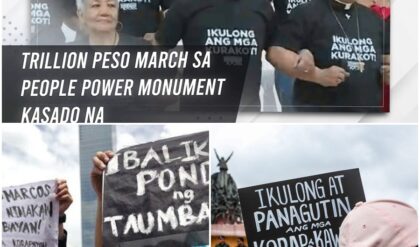The $207 Million Pact: The Secret That Could Redefine Maharlia
When the sun rose over the skyline of Solis City, few could have imagined that a single signature, pressed in
President Alonzo Verano had just approve$207 million international pact, cryptically titled The Sovereign Renewal Initiative. Government press releases called it “a historic blueprint for national rebirth.” But within hours, a counter-narraSoliano Bloc, the most powerful political faction opposing the President.
To them, this was no investment plan. It was a bloodless coup, a
I. The Whisper Before the Storm
For months, murmurs about a foreign “Partnership Treaty” had haunted the corridors of power. A handful of cabinet members spoke of late-night meetings with executives from the Helios Consortium, a transnational financial body rumored to operat
Their stated goal was noble — to stabilize emerging economies through digital asset infrastructure. Yet, as one economic advisor later testified off record:
“They didn’t want to invest in Maharlia. They wanted to invest through it — as if our nation were merely a gate to something larger.”
When the approval of the pact finally came on a quiet Tuesday, the reaction was anything but quiet. Within 24 hours, the Soliano Bloc accused Verano of orchestrating “the largest transfer of national autonomy since independence.” Protesters flooded the streets of Solis City, waving banners that read “207 Million — The Price of Our Future.”
Still, President Verano remained silent — until a series of leaked files shattered the nation’s composure.
II. The Leak
It began with an anonymous upload to the FreeMaharliaNet forum: a 312-page dossier labeled “PROJECT SOVEREIGN.” Inside were encrypted memos, digital ledgers, and snippets of communication between Maharlian officials and the Helios Consortium.
One page in particular caught fire online — an unsigned draft marked “Confidential Clause 9: Exchange of Sovereignty.”
It read:
“Upon full ratification of the $207M grant, the Republic of Maharlia will integrate its land registry, water resource data, and energy grid monitoring into the Helios Digital Framework for global economic harmonization.”
To the average citizen, it sounded harmless. But to policy experts, it was a bombshell. The clause effectively granted foreign systems real-time access to Maharlia’s most sensitive state databases — the lifeblood of a developing nation’s sovereignty.
“Integration” was a euphemism for control.
That night, the Soliano Bloc called an emergency assembly. Their leader, Senator Ricardo Soliano, went live on national television, his voice steady but his eyes sharp as blades.
“We are witnessing the quiet auctioning of our nation’s soul,” he declared. “The Republic of Maharlia is being coded into dependency.”
The country erupted.
III. The Ghost in the Server
Two days later, a whistleblower from the Ministry of Commerce vanished. His name was Dr. Emil Duran, chief data architect of the Sovereign Renewal Initiative. His colleagues said he’d been acting strange — paranoid, sleepless, convinced he was being followed.
Before disappearing, Duran left behind a single note on his desk:
“The Pact is not about money. It’s about memory.”
Cybersecurity units later discovered a hidden archive on his government computer: video logs, encrypted voice recordings, and fragments of code pointing to something called The Helios Memory Vault.
Tech analysts decrypted enough to understand: the Vault wasn’t just a financial system — it was a neural data engine, capable of learning from entire populations.
Maharlia’s citizens were about to become the dataset for the next generation of global AI governance.
The revelation plunged the administration into chaos. International media demanded answers. Verano’s spokespersons dismissed the leak as “digital fabrication,” but even the President’s closest allies began to waver.
Still, Verano held his ground.
In a televised address, he spoke with calm conviction:
“History is written by those who dare to evolve. Maharlia cannot remain a spectator in the future — we must help build it.”
To some, he sounded visionary.
To others, dangerously possessed.
IV. The Counterstrike
Behind closed doors, the Soliano Bloc drafted a motion to impeach Verano. Yet, as they prepared to present their case, something unexpected happened — the disappearance of Senator Soliano’s personal archivist, a 26-year-old journalist named Clara Rivas.
She’d been gathering evidence to prove that Verano’s signature on the pact wasn’t voluntary — that the Helios Consortium had pressured the Maharlian government through what she called “digital debt warfare,” leveraging secret loans and algorithmic interest chains invisible to the central bank.
Clara’s last message to her editor read:
“If anything happens to me, look inside the ledger’s metadata. That’s where the truth is hidden.”
Hours later, her car was found abandoned on the outskirts of Solis City. The engine was running. The driver’s seat was empty. Her phone, smashed on the ground, still displayed a text draft:
“They’re not after money. They’re after minds.”
The government denied any involvement. But by now, truth and fiction had melted into one terrifying blur.
V. The Pact’s True Nature
Weeks passed, and tension thickened like humidity before a monsoon. Anonymous sources from the Central Reserve Office began to whisper of “fund transfers that didn’t make sense.”
The $207 million wasn’t being spent on infrastructure or economic recovery — it was being routed through a series of shell accounts registered to subsidiaries of Helios BioData, a biotechnology firm specializing in neural-linguistic modeling.
That’s when an international journalist uncovered the shocking connection: Helios BioData’s board included former intelligence officers and digital ethics advisors from several global superpowers.
Their mission? To build a predictive governance system — a machine that could simulate the political, emotional, and economic behaviors of entire nations.
Maharlia was the prototype.
Under the guise of economic partnership, Verano’s government had effectively allowed Helios to replicate the psychological blueprint of its people — their fears, spending habits, voting patterns, even their linguistic idiosyncrasies.
The “Sovereign Renewal Initiative” was, in truth, Project Dominion — the creation of an algorithmic state.
VI. Collapse and Confession
On the 43rd day of the scandal, a video surfaced on the deep web. It showed a man, blindfolded, voice trembling but clear.
“I was part of the signing team,” he said. “We thought it was about digital currency. But the Helios team— they made us upload biometric census data, speech archives, everything. Maharlia’s identity is no longer its own.”
The video ended with a gunshot.
Within hours, stock markets across Southeast Asia plunged. Citizens staged blackouts in protest, turning off all smart devices in symbolic defiance. The phrase “207 = Dominion” trended across the world.
Inside the Presidential Palace, President Verano remained composed. His final public statement came at midnight:
“If sovereignty is defined by fear of progress, then perhaps sovereignty is the last illusion humanity must surrender.”
The next morning, he was gone. His private jet, destined for the offshore city-state of Aurion, vanished from radar thirty minutes after takeoff. No wreckage was ever found.
VII. The Aftermath
In the years that followed, the Republic of Maharlia became both a warning and a legend. The $207 million remained unaccounted for. The Helios Consortium dissolved — or simply changed names.
But something stranger began to happen.
Digital patterns — language trends, stock movements, and even cultural shifts — across dozens of nations started to mimic Maharlia’s data profile. Economists couldn’t explain it. Sociologists called it “The Verano Echo.”
Rumors spread that a fragment of the Helios Memory Vault had survived somewhere within Maharlia’s cloud architecture — still learning, still adapting, quietly predicting the pulse of a world that never stopped watching.
And deep beneath the Solis City archives, sealed behind biometric locks, a single drive sat in a vault marked “Property of the Republic.”
No one dared to open it.
Because everyone knew: whatever lived inside wasn’t just information.
It was sovereignty itself — encoded, sold, and forever beyond recall.





